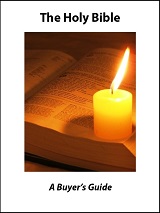What is the best Bible translation? It’s a simple question, but the answer is far from straightforward. There are dozens of modern English translations and hundreds of different editions available. All these translations and editions vary in style, content, religious orientation, and more. Thus, before you can answer the question “What is the best Bible translation?” it is important to first decide what type of Bible you want.

Best Bible Translation: Translational Differences
One of the biggest differences between Bible translations is the style of translation and how closely the translated text reflects the language and meaning of the original biblical text. In the Biblical Archaeology Society’s free eBook The Holy Bible: A Buyer’s Guide, expert Bible scholar Leonard J. Greenspoon breaks down Bible translations into three broad categories: literal translations, nonliteral translations with extended vocabulary, and nonliteral translations with limited vocabulary.
According to Greenspoon, “The literal versions come closest to providing a word-for-word translation in terms of the grammar, vocabulary, and style of the original. Nonliteral versions with extended vocabulary attempt to provide a Bible that remains close to the original but makes use of more up-to-date vocabulary and style. The other nonliteral versions restrict the scope of their vocabulary and the complexity of their grammar. Each of these approaches has its own appeal and drawbacks; for example, a literal version brings modern readers closest to the ancient text, but often at the expense of intelligibility. The less literal a version is, the easier it is for today’s readers to comprehend, but readers can easily lose the feeling that they are dealing with an ancient text.”
Within the category of literal translations are well-known Bible translations such as the King James Bible and the English Standard Version. If you want a word-for-word translation, perhaps one of these is the best Bible translation for you. But if you are looking for something a little easier to read, you might turn towards the nonliteral translations with extended vocabulary. Among these are the Jewish Publication Society’s Tanakh as well as the very popular New International Version. If you want an even more accessible translation, you can turn to nonliteral translations with limited vocabulary. These are often written in modern vernacular and aim to connect with those who are not already familiar with the Bible, who want a more casual reading experience, or who might not be native English speakers. This category includes translations like the Easy-to-Read Version or the Message Bible.
Best Bible Translation: Content Differences
Another major difference in Bibles is their content. This is often, though not always, determined by the intended audience. While the term Bible is used widely, there are several different Bibles, recognized and used by different religions and groups. The Hebrew Bible (or Tanakh), for instance, is made up of 24 books. These same books are divided into 39 books in most Christian traditions. Meanwhile, Christian Bibles usually contain an additional 27 books, referred to as the New Testament. Some Christian traditions add another 15 books called the Apocrypha. Thus, depending on what you mean by “Bible,” the best Bible translation for you could be very different.
Best Bible Translation: Study Aids and Extras
One more big difference in various Bible translations is the inclusion of study aids. Although most modern Bibles include footnotes, the amount and extent of the notes can vary greatly. These notes can be as simple as clarifying the location of a biblical place or defining a technical term. However, footnotes may also include in-depth explanations of doctrine and theology. Other content, including commentaries, cross-references, maps, charts, and illustrations, may also be added to different editions. Some Bible editions are geared towards a specific demographic, such as Zondervan’s Dad’s Devotional Bible. Other editions might provide the Bible in various languages, either multiple modern languages or a modern language alongside the original text. This is the case in the Jewish Publication Society’s Tanakh, in which the English translation and Hebrew text appear side by side.
The Holy Bible: A Buyer’s Guide
Still confused about what might be the best Bible translation for you? Let expert Bible scholar Leonard J. Greenspoon guide you through the content, text, style, and religious orientation of different Bible versions. BAS’s updated eBook The Holy Bible: A Buyer’s Guide provides straightforward, objective, and succinct information on 42 Bible versions and editions. The Holy Bible: A Buyer’s Guide is far from the first such effort, nor will it be the last. What distinguishes this Bible guide from others is that it allows each Bible version to speak for itself.
Read more in Bible History Daily:
All-Access members, read more in the BAS Library:
Not a BAS Library or All-Access Member yet? Join today.The post What Is the Best Bible Translation? appeared first on Biblical Archaeology Society.






0 Commentaires